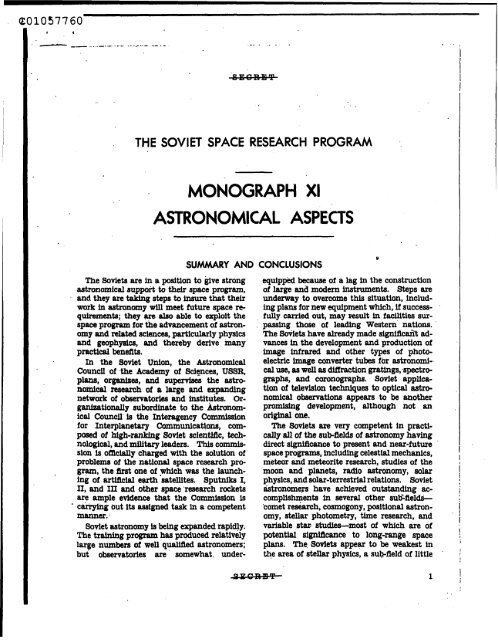4 - The Black Vault
4 - The Black Vault
4 - The Black Vault
You also want an ePaper? Increase the reach of your titles
YUMPU automatically turns print PDFs into web optimized ePapers that Google loves.
GO1057760<br />
THE SOVIET SPACE RESEARCH PROGRAM<br />
Al<br />
MONOGRAPH XI<br />
TRONOMICAL ASPECTS<br />
<strong>The</strong> soviets are in a position to give strong<br />
sstronomical support to their space program,<br />
and they are taking steps to insure that their<br />
work in astronomy will meet future space requirements;<br />
they are also able to exploit the<br />
space program for the advancement of astronomy<br />
and related sciences, particularly physics<br />
and geophysics, and thereby derive many<br />
practical benefits.<br />
In the Soviet Union, the htronomical<br />
Council of the Academy of Sci$nceS, USSR,<br />
plans, organizes, and supervises the astronomical<br />
research of a large and expanding<br />
network of observatoriss and institutes. Organizationally<br />
subordinate to the Astronomical<br />
Council is the Interagency Commission<br />
for Interplanetary Communications, composed<br />
of high-reg Soviet scienttfic, technological,<br />
and military leaders. This commission<br />
is oaScially charged with the solution of<br />
problems of the national space research program,<br />
the first one of which was the launching<br />
of artiflcial earth satellites. Sputniks I,<br />
XI, and 111 and other space research rockets<br />
are ample evidence that the Commission is<br />
- carrying out its assigned task in a competent<br />
manner..<br />
Soviet astronomy is being expanded rapidly.<br />
<strong>The</strong> training program has produced relatively<br />
large numbers oi well qualified astronomers;<br />
but observatories are somewhat under-<br />
SUMMARY AND CONCLUSIONS<br />
equipped because of 8 lag in the construction<br />
of large and modern instruments. Steps are<br />
underway to overcome this situation, including<br />
plans for new equipment which, if successfully<br />
carried out, may result in facilities surpassing<br />
those of leading Western nations.<br />
<strong>The</strong> Soviets have already made 8igniflcaiit advances<br />
in the development and production of<br />
image infrared and otber types of photoelectric<br />
image converter tubes for astronomical<br />
use, as well as dUTraction gratings,spectrographs,<br />
and coronographs. Soviet application<br />
of television techniques to optical astronomical<br />
observations appears to be another<br />
promising development, although not an<br />
original one.<br />
<strong>The</strong> Soviets are very competent in practically<br />
all of the subfields of astronomy having<br />
direct significance to present and near-future<br />
space programs, including celestlal mechanics,<br />
meteor and meteorite research, studies of the<br />
moon and planets, radio astronomy, solar<br />
physics, and solar-terrestrial relations. Soviet<br />
dstronomep have achieved outstanding accomplishments<br />
in several other su&fiel&<br />
comet &h,<br />
- 1<br />
cosmogony, positional astronomy,<br />
stellar photometry, time research, and<br />
variable star- efudies--most of which are of<br />
potential signiflcance to long-range space<br />
plans. <strong>The</strong> Soviets appear to be weakest in<br />
the area of stellar physics, a subfield of little<br />
Y

















